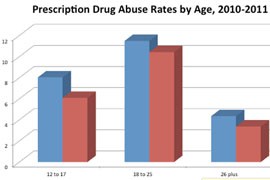Cronkite News has moved to a new home at cronkitenews.azpbs.org. Use this site to search archives from 2011 to May 2015. You can search the new site for current stories.
Arizona posts nation’s sixth-highest prescription drug abuse rate
WASHINGTON – Arizona had the sixth-highest level of prescription pain-reliever abuse in the nation in 2010-2011, according to a recent government report.
The National Survey on Drug Use and Health, released last week, said 5.66 percent of Arizona residents ages 12 and above were misusing prescription drugs in that period, compared to a national rate of 4.57 percent.
But the rate of abuse dropped at both the state and national levels from the previous reporting period in 2009-2010, when the rates were 6.31 percent and 4.89 percent, respectively. Arizona fell from third- to sixth-highest in the nation in the same period.
State officials pointed to that as evidence that their efforts to curb prescription drug abuse appear to be working in Arizona.
“I would say that our efforts have really beefed up in the last two years, and in this year are even much stronger than they were in previous years,” said Lisa Shumaker, prevention services manager in the Arizona Department of Health Services’ Office of Prevention.
Shumaker cited several factors for the relatively high rate of abuse in the state, including overprescribing by doctors, the sale of unused medication and a lack of education about the pitfalls of prescription-drug addiction.
“A lot of times people perceive that if it’s been prescribed by a doctor, it’s been tested by the FDA (Food and Drug Administration), that it’s all safe,” Shumaker said. “But it’s not, unless you’re using it as prescribed by a doctor and you’re under their medical care.”
She said there has been a concerted effort in recent years to address the problem.
In 2007, state lawmakers created the Controlled Substances Prescription Monitoring Program, a database of patients who get prescriptions for powerful pain relievers. Doctors are encouraged, but not required, to check the database before writing a prescription to make sure patients are not doctor shopping.
Other efforts include new polices to help guide doctors prescription practices, procedures for people to safely dispose of drugs that are no longer being used and programs to educate communities about the dangers of prescription drug misuse.
Shumaker said the state is also testing a program to curb prescription drug abuse in Graham, Pinal and Yavapai counties. If the new techniques are effective, Shumaker said they could be adopted statewide.
The program is heavy on education, offering a drug-free presentation that can shown to community groups and another for high schools and middle schools. It also teaches police, pharmacists and doctors how to use the state’s prescription monitoring program to stop overprescribing and doctor-shopping.
The program will begin Jan. 30 in Graham County, but Kathy Grimes said the county has been working on the problem of prescription drug abuse since 2008.
“There are lots of contributing factors, and that’s why as a community we need to work together to stop the problem,” said Grimes, director of the county’s Substance Abuse Coalition.
She said Graham County has gone from the fourth-highest rate of prescription drug abuse in the state in 2010 to the 15th in 2012, lowest in the state.
“I like to believe what we’re doing is really making a difference, that either the prescriptions are either not as available or maybe it’s because we’re educating our community,” Grimes said.
She and Shumaker also pointed to the biennial Arizona Youth Survey, which samples students in grades 8, 10 and 12 for several categories, including drug use. It showed the percentage of students who used prescription drugs in the previous 30 days dropped from 10.4 percent statewide in 2010 to 7.9 percent in 2012.
Arizona was not alone in its decline: The National Survey on Drug Use and Health reported a decrease in prescription pain reliever abuse in 40 states.
“Bottom line, (the data) is really good news,” said Peter Delany, director of the Center for Behavioral Health Statistics and Quality, which is responsible for the collection and analysis of data with the Substance Abuse and Mental Health Services Administration.
Delany would not go so far as to say preventive measures were the cause of the decline, but that “we may be getting to see some level of impact” from prevention, treatment and law enforcement policies.
Delany pointed to an increased effort toward educating consumers, doctors, pharmacists and the general public of the dangers of prescription drugs as one possible factor in the decline.
He also said programs like Arizona’s that let doctors see if patients have shopped around for prescriptions could be limiting the supply of drugs available.
“Have we gotten to where we need to be? Obviously not, because there are still a lot of people using prescription pain relievers,” Delany said.
According to the report, Western states tended to have a higher rate of prescription drug abuse. The top four states were Oregon, Colorado, Washington and Idaho and three other Western states – Arizona, Nevada and New Mexico – were in the top 10.
Delany said there wasn’t any clear reason why the West had higher rates, but one factor might be that prescription drug misuse tends to be higher in rural areas.








